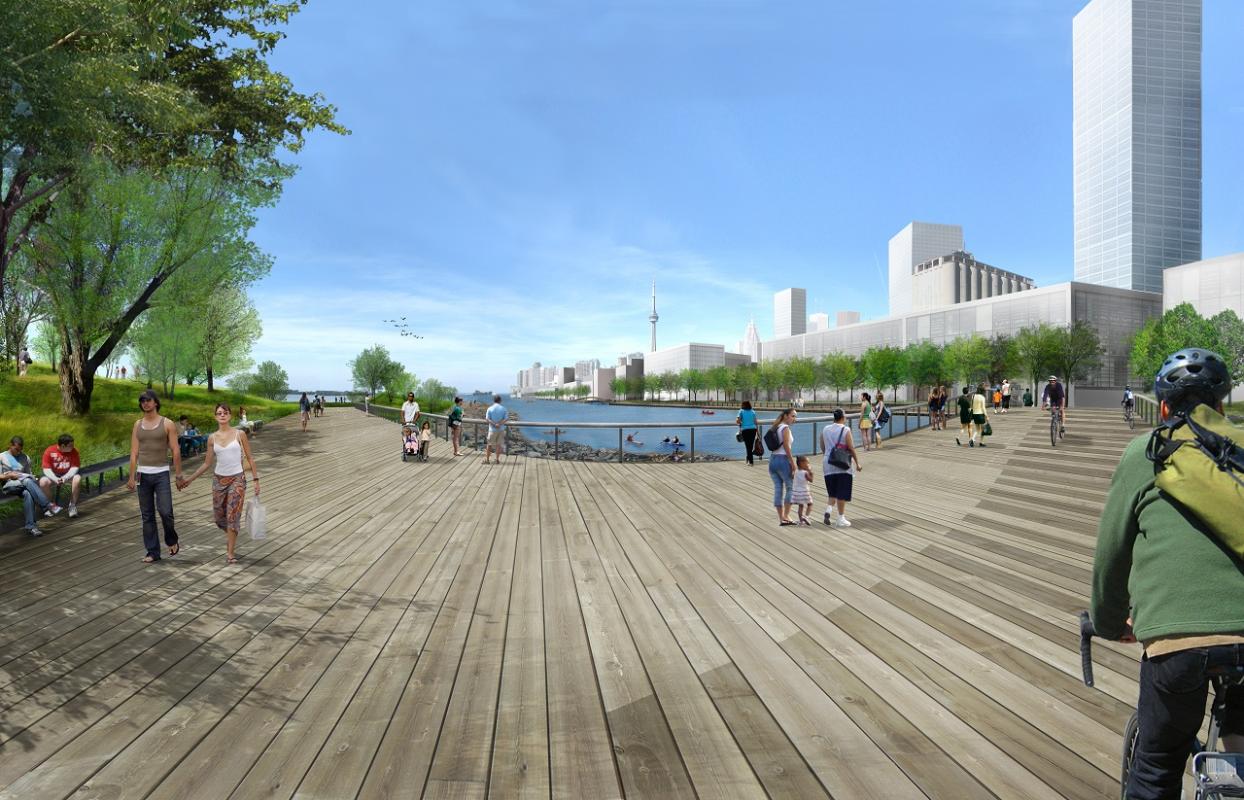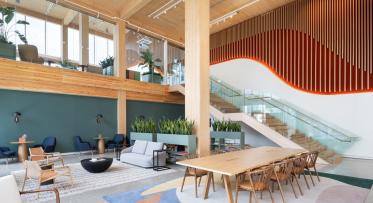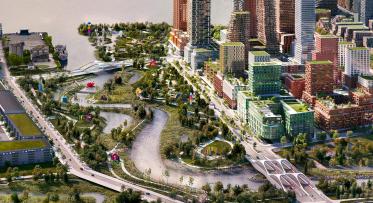Waterfront Toronto Seeking Offficial Plan Amendment for Lower Don Lands
July 5, 2010, Toronto, ON - The award winning vision to transform the Lower Don Lands and renaturalize the mouth of the Don River may soon be official and binding.
Waterfront Toronto, in conjunction with the City of Toronto and Toronto and Region Conservation, is seeking Toronto City Council’s authorization to submit all the necessary planning documents that would ultimately result in an Official Plan Amendment for the Lower Don Lands plans. The Official Plan Amendment would pave the way for future revitalization of the area including rerouting the river, building flood protection and ultimately building new communities.
At its July 6/7 meeting, Council will be asked to endorse the draft Don Mouth and Lower Don Lands environmental assessments. If endorsed, the draft Don Mouth Environmental Assessment will then be submitted to the Ministry of the Environment for final approval under the Environmental Assessment Act.
Council will also be asked to endorse an Official Plan Amendment and new Zoning By-law, which require review by the Ministry of Municipal Affairs and Housing and the Ministry of Natural Resources for consistency with flood management policies. If passed by Council in August, Toronto’s Official Plan will be amended to enshrine the Lower Don Lands plans and will bring the project to a point of readiness where funding and economic development opportunities can be seized.
The plans were already unanimously endorsed by Toronto City Council’s Executive Committee on June 14 and by Toronto and East York Community Council on June 22.
“This is a pivotal moment for the future of the Lower Don Lands and is the culmination of years of planning, design and public consultation,” said John Campbell, President and CEO, Waterfront Toronto.“ The plans for the Lower Don Lands represent a unique opportunity to remake a significant and vital part of Toronto’s waterfront.”
Until now, regeneration and development of the Lower Don Lands has been hindered by a number of factors including flood risk, isolation from the rest of the city, soil and groundwater contamination and insufficient infrastructure. The Lower Don Lands plans address and overcome all of these factors, and will transform this post-industrial area into a sought-after destination to live, work and play based on design excellence, ecology and economic sustainability.
Following an international design competition in 2007, the plans were developed by a team led by world renowned landscape architectural firm Michael Van Valkenburgh Associates Inc (MVVA). The plans were taken through a rigorous technical analysis as part of a comprehensive environmental assessment. The process looked at several options and ultimately led to the development of the preferred alternative. The MVVA led team used an integrated design approach – the collaboration of landscape architects, urban designers and leading sustainability experts –which brought together infrastructure, public realm, and ecology to connect the city, lake and river in a dynamic and balanced relationship at the mouth of the Don River.
The plans renaturalize the mouth of the Don River by rerouting it through the Lower Don Lands and at the same time protect more than 230 hectares (568 acres) of land currently at risk due to flooding. The flood mitigation measures eliminate a potential billion dollar-plus flood risk, while simultaneously unlocking the economic development potential for the lands.
The strategies embedded in this approach expand development opportunities for building at the edge of a naturalized river park setting. Under the plans the water’s edge will almost double and 49 hectares (120 acres) will be allocated to parks and open spaces. Comprehensive economic impact assessments project that the plans will result in:
- $480 million in incremental increases in land value in the Lower Don Lands, before build-out;
- $300 million in increased land value in surrounding neighbourhoods;
- $55 million in new annual tax revenue in the Lower Don Lands; and
- $6.8 billion in private investment leveraged in the Lower Don Lands.
“In addition to the economic and environmental benefits to the City, the plans create a unique opportunity for Toronto to showcase its leadership in progressive and sustainable city building,” said Campbell. “Reconnecting Toronto and the Don River at the edge of Lake Ontario will transform Toronto’s waterfront into an internationally recognized destination that combines sustainable city building with major river restoration and naturalization.”
Waterfront Toronto’s plans for the Lower Don Lands have received several prestigious international awards including accolades from the Royal Architectural Institute of Canada, the American Institute of Architects, and the Building Exchange (BEX) Conference.
The Lower Don Lands project is also one of 18 founding projects of the Climate Positive Development Program. A project of U.S. President Bill Clinton's Climate Initiative and the U.S. Green Building Council, the program’s aim is to demonstrate sustainable urban growth models and support large urban developments in achieving zero carbon emissions.
The Lower Don Lands has been designed to achieve climate-positive goals using passive design, optimizing climatic effects from sun and wind, and prioritizing transit and multi-modal transportation options. Energy planning raises the bar for energy efficiency, deemphasizing reliance on the grid. The design also includes strategies for water re-use and leading edge information technology to support sustainable living and working.
The planning process for the Lower Don Lands has included extensive community and stakeholder consultation. Numerous meetings with the public, non-profit agencies, community groups, private land owners and other stakeholders were held throughout the process.
The Governments of Canada and Ontario and the City of Toronto created Waterfront Toronto to oversee and lead the renewal of Toronto’s waterfront. Public accessibility, design excellence, sustainable development, economic development and fiscal sustainability are the key drivers of waterfront revitalization.
Media Contact:
Tari Stork, Manager, Project Communications, Waterfront Toronto




